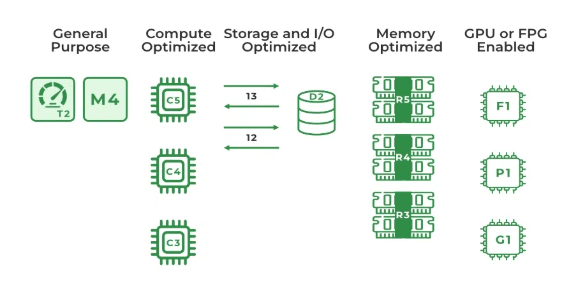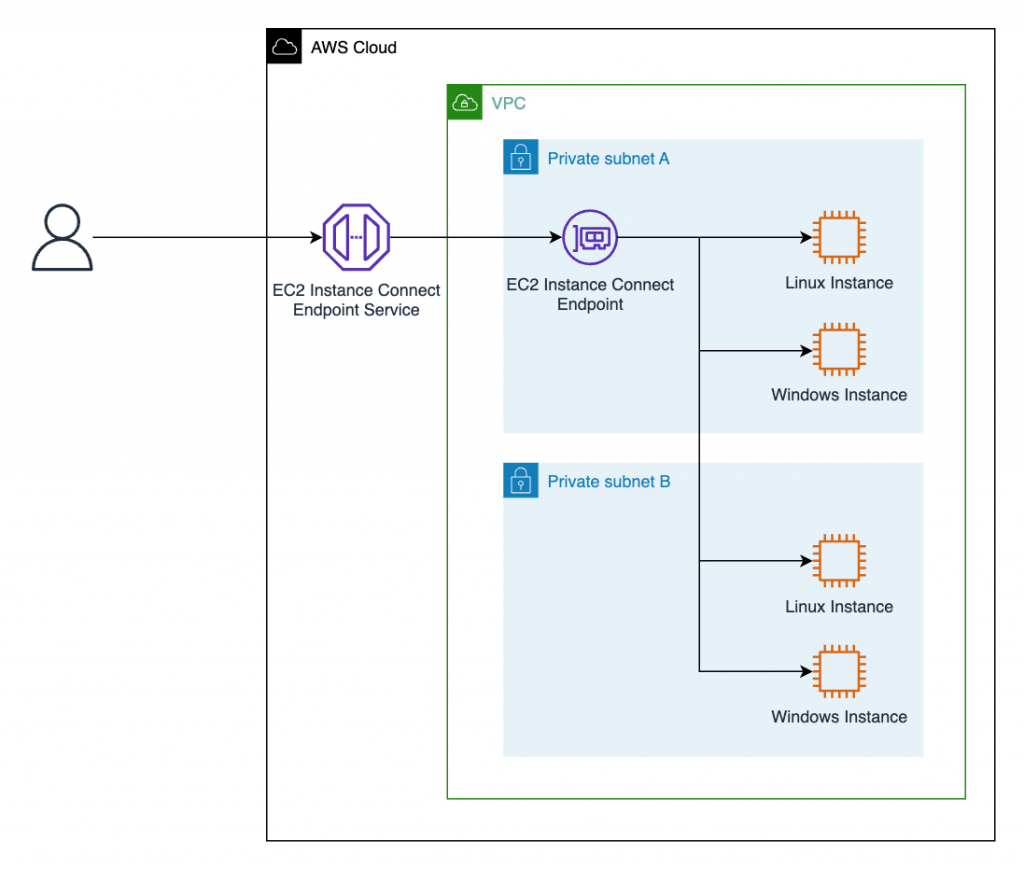
- Introduction to AWS EC2
- Overview of EC2 Instance Types
- General Purpose Instances
- Compute-Optimized Instances
- Memory-Optimized Instances
- Storage-Optimized Instances
- Accelerated Computing Instances
- Choosing the Right EC2 Instance Type
- Pricing Models and Cost Optimization
- Auto Scaling and Load Balancing
- Use Cases for Different EC2 Instances
- Best Practices for Managing EC2 Instances
- Conclusion
Introduction to AWS EC2
Amazon Elastic Compute Cloud (Amazon EC2) is one of the core services that Amazon Web Services (AWS) provides, enabling users to rent virtual servers, known as instances, on demand. AWS EC2 Spot Instances this scalable computing capacity allows businesses to reduce the complexity and overhead of maintaining physical servers while taking full advantage of the flexibility and scalability of cloud infrastructure. EC2 provides a variety of instance types, each optimized for different workloads. Selecting the right instance type is crucial for balancing performance and cost.
Overview of EC2 Instance Types
Amazon EC2 (Elastic Compute Cloud) offers a variety of instance types designed to meet the specific needs of different workloads, providing flexibility and scalability for a wide range of applications. These instances are categorized into several types based on their intended use. General-purpose instances offer a balanced mix of compute, memory, and networking resources, making them suitable for various applications, including web servers, small to medium-sized databases, and development environments. Compute-optimized instances are ideal for workloads requiring high processing power, such as scientific simulations, batch processing, and gaming. These instances focus on providing more CPU performance. Memory-optimized instances are designed for applications that require a large amount of memory, such as high-performance databases, real-time big data analytics, and in-memory caches—topics often covered in Amazon Web Services Training . For workloads that involve large datasets with high input/output requirements, storage-optimized instances are the best choice, offering high disk throughput and low-latency storage. Lastly, accelerated computing instances are equipped with specialized hardware, like GPUs or FPGAs, for workloads that benefit from hardware acceleration, including machine learning, deep learning, and video rendering. Each EC2 instance type offers a unique combination of CPU, memory, storage, and networking resources, enabling users to select the ideal configuration for their specific needs.
Excited to Obtaining Your AWS Certificate? View The AWS Course Offered By ACTE Right Now!
General Purpose Instances
General-purpose EC2 instances are designed to provide a balanced mix of computing, memory, and networking resources. They are suitable for a wide range of applications, including web servers, development and test environments, small and medium databases, and enterprise applications.
- Balanced resource configuration.
- Suitable for a wide variety of workloads.
- Support for burstable performance.
- T3/T3a: Low-cost, burstable performance instances suitable for small and medium-sized workloads.
- M5/M5a: Instances that balance computing, memory, and networking resources, ideal for general-purpose applications.
- Use Cases: Websites, development environments, microservices, and small databases.
Key Features:
Examples:

Compute-Optimized Instances
Compute-optimized EC2 instances are ideal for applications that require high CPU performance, such as batch processing, gaming, video encoding, and high-performance web servers. These instances are optimized for computationally intensive applications with high processor performance. They offer high CPU performance and capacity, designed specifically for workloads requiring frequent processing power. Instances like C5 and C5n are tailored for compute-intensive applications, offering a high ratio of CPU to memory, while C6g instances are powered by AWS Graviton2 processors, providing excellent compute performance at a lower cost. Common use cases include Performance Testing , high-performance computing (HPC), scientific modeling, media transcoding, and data analytics. By leveraging these instances, organizations can significantly reduce processing times for complex tasks, enabling faster insights and more efficient operations. The combination of high performance and scalability makes compute-optimized EC2 instances essential for businesses with demanding computational needs. Additionally, their cost-effectiveness when paired with Graviton2 processors provides substantial savings for large-scale operations.
Memory-Optimized Instances
Memory-optimized EC2 instances are designed for workloads that require high amounts of memory to process data quickly, such as large databases, real-time big data analytics, and high-performance in-memory caches.
- High memory capacity and bandwidth.
- It is ideal for applications with large datasets and memory requirements.
- R5/R5a: Instances designed for memory-intensive applications like in-memory caches and relational databases.
- X1/X1e: Instances with even more significant amounts of memory for in-memory databases, SAP HANA, and big data analytics.
- Use Cases: In-memory databases, real-time big data analytics, and high-performance computing.
- High-performance computing with specialized hardware.
- Designed for workloads requiring GPUs, FPGAs, or machine learning acceleration.
- P3: Instances optimized for machine learning, AI training, and high-performance computing with NVIDIA V100 GPUs.
- G4dn: Instances designed for machine learning inference, graphics rendering, and video transcoding with NVIDIA T4 Tensor Core GPUs.
- Use Cases: Machine learning, deep learning, AI inference, and high-performance gaming.
- On-Demand Instances: Pay for computing capacity by the hour or second, with no long-term commitments. This is ideal for workloads with unpredictable or short-term usage patterns.
- Reserved Instances (RIs): Commit to a one- or three-year term for a discount on instance pricing. Reserved instances are ideal for predictable workloads with steady resource usage.
- Spot Instances: Purchase unused EC2 capacity at a significantly reduced price. Spot instances are ideal for flexible, fault-tolerant applications that can handle interruptions.
- Savings Plans: Flexible pricing plans that offer cost savings in exchange for a commitment to a consistent amount of usage (e.g., compute usage in any region).
- Leverage Spot Instances for non-critical tasks.
- Opt for Reserved Instances for predictable workloads.
- Monitor and analyze usage patterns with AWS Cost Explorer.
- Use Auto Scaling to adjust the number of running instances based on demand.
- General Purpose (T3, M5): Web hosting, small to medium-sized databases, development environments, and applications that require a balance of CPU, memory, and storage.
- Compute-Optimized (C5): High-performance web servers, gaming servers, media transcoding, and scientific modeling.
- Memory-Optimized (R5): In-memory caches, relational and NoSQL databases, big data analytics, and real-time analytics.
- Storage-Optimized (I3): High-performance transactional databases, data warehousing, log processing, and analytics.
- Accelerated Computing (P3, G4dn): Machine learning training, scientific simulations, 3D rendering, and video rendering.
Key Features:
Examples:
Excited to Obtaining Your AWS Certificate? View The AWS Training Offered By ACTE Right Now!
Storage-Optimized Instances
Storage-optimized EC2 instances are designed to handle workloads requiring high, sequential read and write access to large datasets stored locally on the instance. These instances provide the highest throughput and lowest latency for applications that require large amounts of local storage. With high disk throughput and low latency, storage-optimized instances are ideal for applications demanding large-scale, high-performance storage. For example, I3 instances are equipped with high-speed storage optimized for transactional databases, NoSQL databases, and real-time data analytics, while D2 instances focus on dense storage for data warehousing and large-scale log processing. Common use cases for these instances include data warehouses, log processing, big data analytics, and high-performance databases. These instances enable seamless handling of massive datasets, providing low-latency access and high I/O performance. They support critical workloads that require consistent and rapid access to data, improving efficiency in data-heavy applications. The ability to scale storage and compute power also makes them ideal for businesses working with big data environments, Big Data Analytics, and other resource-intensive applications. Additionally, the cost-effective storage capacity allows for more flexibility in managing large datasets without compromising on performance.
Accelerated Computing Instances
Accelerated Computing EC2 instances are optimized for workloads that require specialized hardware accelerators, such as GPUs and FPGAs, for computationally intensive tasks like machine learning, deep learning, scientific simulations, and 3D rendering.
Key Features:
Examples:
Choosing the Right EC2 Instance Type
Choosing the right EC2 instance type depends on several factors related to the workload, including the computing power, memory, storage, and network capacity required by the application. The first step is to understand the workload characteristics, such as whether the application is CPU-bound, memory-bound, storage-bound, or requires specialized hardware like GPUs. For instance, compute-optimized instances like C5 are ideal for CPU-heavy tasks, while memory-optimized instances like R5 are better suited for applications with large datasets. Performance versus cost is also an important consideration—burstable performance instances like T3 are cost-effective for workloads that experience occasional CPU spikes, while high-performance instances like C5 and R5 are better for demanding applications. Scalability is another factor to consider; if your application needs to scale horizontally, instances like T3 or M5 can provide the flexibility required, and understanding these options through AWS Training can be highly beneficial. Additionally, networking requirements should guide your choice—if high network throughput is necessary, instances like the C5n series provide higher bandwidth to accommodate such needs. It’s essential to balance these factors to ensure optimal performance, efficiency, and cost-effectiveness. Furthermore, leveraging AWS’s instance selection tools and regularly monitoring workloads can help you refine your instance choice over time. Lastly, for specialized needs such as GPU workloads or FPGA, selecting instances like P4 or F1 would ensure the best performance for these specific applications.
Are You Considering Pursuing a AWS Master’s Degree? Enroll For AWS Master Course Today!
Pricing Models and Cost Optimization
Amazon EC2 offers multiple pricing models, allowing you to optimize costs based on your usage patterns. The main pricing models include:
Cost Optimization Strategies:
Auto Scaling and Load Balancing
EC2 Auto Scaling automatically adjusts the number of Amazon EC2 Instances Types based on traffic demand, ensuring that your application has the right amount of compute capacity to handle fluctuations in traffic. This helps optimize costs by scaling resources only when needed and ensures high availability of your application. You can set scaling policies to scale out (add instances) or scale in (remove instances) based on key metrics such as CPU usage or network traffic. To complement Auto Scaling, AWS Elastic Load Balancing (ELB) distributes incoming traffic across multiple EC2 instances, ensuring fault tolerance and maintaining high availability. There are three types of load balancers: the Application Load Balancer (ALB), which is best for HTTP/HTTPS traffic and microservices; the Network Load Balancer (NLB), ideal for TCP traffic requiring high throughput and low latency; and the Classic Load Balancer (CLB), which is the legacy option for EC2 instance load balancing. By combining Auto Scaling with ELB, organizations can ensure that their applications are always responsive and resilient, regardless of traffic changes. These services work together to automatically scale and distribute traffic, reducing manual intervention and improving overall system efficiency. Additionally, monitoring traffic patterns and adjusting policies accordingly ensures that resources are always aligned with current demand, improving cost-efficiency.

Use Cases for Different EC2 Instances
Preparing for AWS Job Interview? Check Out Our Blog on AWS Interview Questions & Answer
Best Practices for Managing EC2 Instances
To optimize the performance and cost of your EC2 instances, use Auto Scaling to automatically adjust the number of instances based on traffic demand, reducing costs and maintaining high availability. Additionally, monitor your EC2 instances with Amazon CloudWatch, which tracks metrics such as CPU usage, memory utilization, and disk I/O, allowing you to set up alarms for anomalous behavior that could indicate performance issues. For security, assign appropriate AWS IAM roles to your EC2 instances to control access to other AWS services, ensuring that sensitive resources are protected. Regularly updating and patching your instances with the latest security updates is crucial to mitigating vulnerabilities and maintaining a secure environment. Leverage Amazon Elastic Block Store (EBS) for persistent storage, allowing data to persist across reboots and providing highly available storage for your applications. Automate instance provisioning with AWS Cloudformation or AWS Elastic Beanstalk, ensuring consistent and repeatable infrastructure deployments. This not only enhances operational efficiency but also minimizes human errors in managing complex infrastructure. Additionally, incorporating automated scaling and resource management allows your system to adapt to changing workloads seamlessly. By combining these strategies, you can optimize both the performance and security of your EC2-based applications. Finally, setting up regular audits of your configurations ensures compliance and security best practices are followed consistently.
Conclusion
AWS EC2 offers a highly flexible and scalable environment suitable for various applications. You can optimize performance and cost efficiency by selecting the appropriate instance type based on your workload requirements. Whether you need general-purpose, compute-optimized, memory-optimized, storage-optimized, or accelerated computing instances, EC2 provides the right resources to match different tasks. Additionally, features like Auto Scaling and Load Balancing—topics covered in AWS Training help ensure high availability, automatic scaling of resources, and efficient utilization, improving application performance and resilience. Adopting best practices for EC2 instance management, such as security configurations, monitoring, and regular updates, further enhances performance, minimizes risks, and ensures smooth operation. With these tools and strategies, AWS EC2 provides a powerful platform for running applications efficiently while maintaining flexibility and control.





